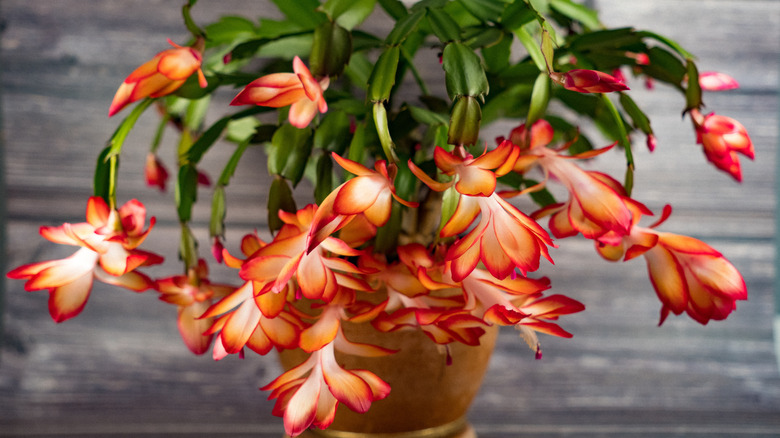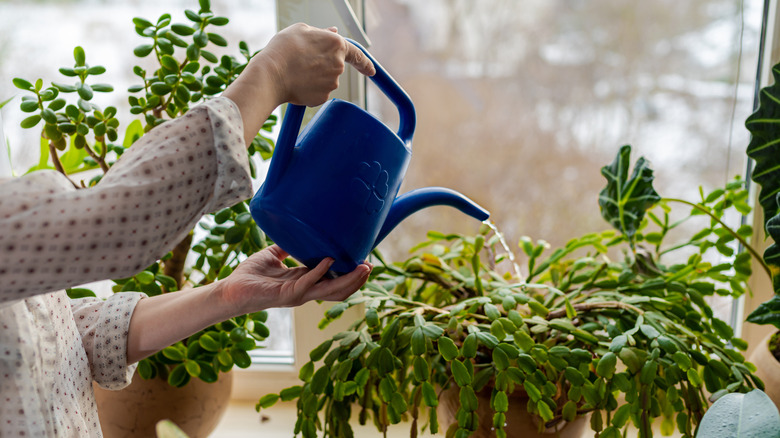The Best (And Worst) Fertilizer For Gorgeous Christmas Cactus Blooms
We may receive a commission on purchases made from links.
Nothing will brighten up your indoor decor more than a Christmas cactus that's absolutely dripping with the most stunning vibrant blooms. But to get this type of magnificent display that will wow your family and friends, you will need to know a little about fertilizers so you can ensure you feed your plant the best. Common houseplant fertilizers have three main nutrients: nitrogen, phosphorus, and potassium. Each of these have a different function in promoting growth. So, not all fertilizers designed for indoor plants will produce the same results for all species. For a flowering plant, like the Christmas cactus, you need to select a fertilizer that primarily promotes blooming. The best fertilizer for gorgeous blooms is one that's higher in phosphorus, while the worst one you could use is one which contains copious amounts of nitrogen.
While this might sound a bit confusing if you don't have an in-depth knowledge of fertilizers, it's actually relatively simple to explain. At the most basic level, nitrogen promotes green plant growth, phosphorus encourages flowering and strong root development, and potassium is primarily responsible for general health and disease resistance. Now that you know this, it should make perfect sense that a fertilizer with higher amounts of phosphorus will encourage your Christmas cactus to produce more blooms. On the other hand, one that's balanced or higher in nitrogen, will often result in lots of new growth but not as many flowers.
How do you select the best fertilizer for a Christmas cactus?
When you're perusing all the different fertilizers available, select one that's specifically for flowering plants. This is usually specified on the label but you can dig a little deeper to see what the N-P-K breakdown is. N-P-K stands for nitrogen (N), phosphorus (P), and potassium (K) and is always defined in that order. For example, the Schultz African Violet Plus plant food has a ratio of 8-14-9. This should tell you immediately that it contains more phosphorus than nitrogen, making it perfect for flowering species. You'll also see on the label that it's designed for not only African violets but other blooming plants as well.
As an example of one of the worst fertilizers for encouraging your Christmas cactus to bloom, take a look at the Espoma Organic Indoor houseplant food. Sometimes, you have to look on the back label to find out what the nutrient ratio is. This popular product has an N-P-K breakdown of 2-2-2. While this is ideal for all the indoor species you grow for their lush foliage, it's not going to help your Christmas cactus produce an abundance of blooms. Armed with this information, you should now be able to look at any fertilizer pack and determine whether it will be suitable for the plants you're growing. You also want to be aware that Christmas cacti have a higher need of magnesium, which is why Epsom salts may be another secret to a flourishing plant.
Here's the trick to the perfect fertilizer schedule
For optimum results, you actually want to feed your Christmas cactus with two different fertilizers at separate times of the year. Apply a balanced fertilizer at half strength during the summer months to encourage new growth. This is quite important if you want loads of flowers, because these plants will only flower on the ends of their stems. So, the more new stems you have, the more blooms you're likely to get. Another tip is to pinch back the stems in the spring or at the very beginning of summer by just cutting off one or two stem segments from numerous branches. This should result in two new sections growing from each pruning point. Don't throw away those bits you've cut off though, because you can utilize them to fill your home with free Christmas cacti by using a simple propagation technique.
In the fall, you want to switch your fertilizer to one that's higher in phosphorus and potassium, and only has a small amount of nitrogen, as this is when the flower buds will be forming. Once again, as a general rule, you should only apply this at half-strength. As soon as your plant is blooming, you can stop fertilizing and resume this regime again the following summer. Finally, now that you have a healthy, thriving plant that's overflowing with flowers, you'll want to know the best way to repot your Christmas cactus to keep it flourishing.


